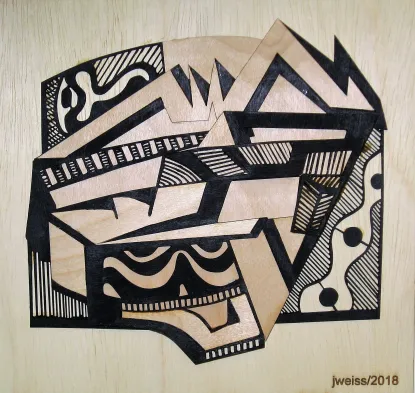By Julie Anderson
Flinn Foundation

During his time as a pediatrician, amid countless medical conferences and meetings, Dr. Jeff Weiss began creating detailed artistic designs to pass the time in-between lectures.
Soon enough, Weiss was giving away his doodles to interested friends and colleagues.
“Whenever I would sit down and try to draw, I never was able to do that very well. But when I was listening to a lecture, and just sort of zoned out and doodling at the same time, I got these elaborate geometric designs,” Weiss says.
He calls this style of art “unconscious drawing” and considers it his specialty.
Before Weiss began creating art, and even before he launched his successful career, Weiss knew he was meant to work with children. The retired pediatrician and hospitalist had an interest in common childhood illnesses, a hobby of performing magic tricks, and a personality he believed fit the role of a pediatric physician.
“I went in [to pediatrics] because I like to take care of the kinds of illnesses that kids get—infectious diseases, genetic problems, growth and development issues, injuries—so it seemed to fit,” Weiss says. “And then, as a side, I’d do magic for the kids. And so that was a perfect fit because I could make them laugh and distract them when they were in pain.”
After moving to Arizona in 1993, Weiss worked at the Maricopa Medical Center for a short time before arriving at Phoenix Children’s Hospital, where he would remain for the rest of his career. He served on the Academy of Pediatrics Injury Committee for six years, during which time, Weiss wrote the policy statements for teen driving, drowning prevention, and pedestrian injury. Additionally, Weiss started the Division of General Pediatrics at Phoenix Children’s at a time when the hospital was making the switch from outpatient pediatric coverage to an inpatient hospitalist model of care, which meant Weiss saw patients from all around the state.
Weiss officially retired from Phoenix Children’s Hospital in June 2021, but before that, while semi-retired and during the summer—a traditionally slow time for children’s hospitals—Weiss began volunteering at the Arizona Science Center in its CREATE makerspace. It was here that he saw a way (and a tool) to transform his doodles into tangible pieces of art.

“When I was at the Science Center, they had these things called tabletop activities, where you would lay out your activity on this table. I had two tabletop activities that I did. One was [about] optical illusions. And the other one was [about] the heart,” Weiss says.
He then began working on a laser cutter, taking his napkin designs and constructing them out of wood and then gluing and assembling them.
Weiss’ process, and the way he conceptualized it, evolved with the change in materials as well, to what he describes as “subconscious constructions.”
“It’s the idea that [the drawings] were constructed sort of piece by piece as I was doodling along. And then, when I started cutting them out of wood with the laser cutter, I called it ‘constructing the constructions,’” Weiss says.
He eventually found ways to express himself and his views on topical subject matter, some of which relate back to his work as a pediatrician.
“On the Injury Prevention Committee, we worked on a lot of efforts to limit gun violence. And so, when there was a school shooting, I was stimulated to do laser cuts of bullet holes…and it’s probably one of the grossest pieces I’ve done,” Weiss says.
After encouragement from loved ones, specifically a friend from college that was also a physician and artist, Weiss began entering his creations into exhibitions and art shows, though he is still reluctant to call himself an artist.
“I can’t say I really am yet comfortable calling myself an artist. With pediatrics, I felt … very competent in my professional abilities. I don’t feel that in art yet,” Weiss says.
But Weiss is being noticed for his art. He was a featured artist in the latest Flinn Foundation art exhibition for his piece, “Kernicterus,” which was on display at the foundation’s central Phoenix building earlier this year.
Weiss said he has felt validated with his success submitting to various shows and selling some of his pieces.
Weiss has already started experimenting with a new artistic process for his own work, a style favored by surrealist artists called decalcomania.

“I compress paint between two layers and then pry the layers apart. And you get this very interesting, fingering-like pattern, almost like a Rorschach [test inkblot],” Weiss says.
Weiss continues to have an interest in creating intricate visual illusions that get people thinking.
“What I like about these pieces is people look at these abstract works and they try to find things in the fingering; there’s almost designs in there. They say, ‘Oh, I see mountains. Oh, I see waterfalls. Oh, I see an underwater scene.’ And I’m not thinking about any of that.
“So, what I like about these new pieces that I’ve been doing for a little over a year now is that people seem to want to use their imagination and find stuff in there. And that’s great,” Weiss says.
Having lived a life as a physician and artist, Weiss believes there is room in medicine to be creative which can lead to figuring out the best ways to manage a patient.
“I think the research part of it is very, very connected to art. I think in art…you sort-of do something, you make a mistake, you try to fix it. Sometimes you do, sometimes you don’t,” Weiss said. “And that aspect is somewhat like medicine; you’re always trying something new, making sure that the outcome is the best.”